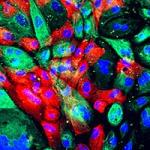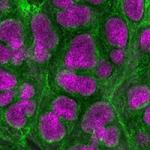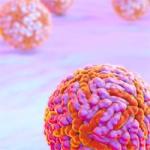
Katherine McJunkin, Ph.D.
Senior Investigator
Section On Regulatory RNAs, Laboratory of Cellular & Developmental Biology
NIDDK
Research Topics
Research Goal
MicroRNAs (miRNAs) play an essential role in most physiological processes in animals and plants, including development, differentiation and behavior. However, both the role of miRNAs in embryogenesis and the temporal regulation of miRNAs via turnover are poorly understood. Our research group will define the biological functions of miRNAs in the embryo and the mechanisms of miRNA turnover. To address these questions, we will combine the strengths of classical C. elegans forward genetics with CRISPR-Cas-9-mediated genome editing, next-generation sequencing, cell biology, and biochemical techniques. Because embryonically-expressed miRNAs exhibit a sharp decrease in abundance at the end of embryogenesis, our efforts to simultaneously study the biology of these miRNAs and the mechanism of miRNA decay has the potential to uncover regulatory modules that couple miRNA decay to developmental timing.
Current Research
MiRNAs are small noncoding RNAs that are loaded into Argonaute proteins to form the core of the miRNA-Induced Silencing Complex (miRISC). MiRNAs guide miRISC to complementary target mRNAs to silence their expression. Mutations in miRNA loci disrupt gene expression programs, and thus can contribute to the development of various diseases, including cancer. Consequently, understanding both the functions of miRNAs in normal development and the molecular mechanisms that regulate miRNAs are biological questions of critical importance.
Understanding the biological functions of miRNAs during embryogenesis
While the functions of miRNAs in differentiated tissues are well-studied in C. elegans and other organisms, the embryonic functions of only a few animal miRNAs are understood. Moreover, how miRNAs contribute to the largely post-transcriptional control of gene expression prior to the maternal-to-zygotic transition (MZT) is completely unknown. C. elegans is an excellent model organism in which to study embryonic development due to its well-defined stereotypic cell lineage and powerful genetic tools. Our group will use C. elegans to elucidate the functions of miRNAs in embryogenesis, first focusing on the miRNA families that are required for embryogenesis.
To dissect the biological pathways controlled by these miRNAs, our group will conduct forward (mutagenesis) and reverse (RNAi) screens for suppressors of microRNA family mutant phenotypes. Understanding the biological networks impacted by the embryonically-expressed microRNA families will yield important insights into how gene expression is controlled to coordinate embryogenesis.
Defining the molecular mechanisms of miRNA and Argonaute turnover
The balance of the rates of miRNA biogenesis and decay control miRNA abundance, and thus gene expression programs. Previous research has carefully elucidated mechanisms of miRNA biogenesis. However, we know very little about how miRNAs and miRISC are turned over – either constitutively or in a regulated manner. This is a major gap in our understanding of miRNA regulation, and thus the regulation of gene expression. We will use deep sequencing to assess the contribution of candidate players in microRNA turnover, as well as identify novel effectors and regulators of miRNA turnover.
A major unanswered question is whether the miRNA and its protein binding partner Argonaute are targeted for degradation together, or can instead be turned over separately. By measuring the effect of changes in miRNA turnover kinetics on Argonaute turnover kinetics, and vice versa, we will investigate how these events are interconnected. In the long term, we will thus establish a hierarchy of events in the process of miRISC turnover.
Applying our Research
Understanding the regulation of miRNAs by turnover may lay the foundation for new modalities to treat human disease. This area of study could impact the treatment of cancer, since miRNAs are known to be globally downregulated in many cancer types, and miRNA biogenesis enzymes can act as haploinsufficient tumor suppressors. These data suggest that a modest increase in miRNA abundance could reverse the contribution of miRNAs to cancer. Thus, inhibition of miRNA turnover is an attractive therapeutic strategy. Since enzymes are likely to play a part in this process, small molecules inhibitors of miRNA turnover could be feasible as a targeted cancer therapy.
Biography
- Postdoctoral Fellow, University of Massachusetts Medical School, 2011-2017
- Ph.D., Watson School at Cold Spring Harbor Laboratory, 2010
- B.A., Princeton University, 2005
Selected Publications
- Kotagama K, Grimme AL, Braviner L, Yang B, Sakhawala RM, Yu G, Benner LK, Joshua-Tor L, McJunkin K. Catalytic residues of microRNA Argonautes play a modest role in microRNA star strand destabilization in C. elegans. Nucleic Acids Res. 2024;52(9):4985-5001.
- Donnelly BF, Yang B, Grimme AL, Vieux KF, Liu CY, Zhou L, McJunkin K. The developmentally timed decay of an essential microRNA family is seed-sequence dependent. Cell Rep. 2022;40(6):111154.
- Vieux KF, Prothro KP, Kelley LH, Palmer C, Maine EM, Veksler-Lublinsky I, McJunkin K. Screening by deep sequencing reveals mediators of microRNA tailing in C. elegans. Nucleic Acids Res. 2021;49(19):11167-11180.
- Yang B, Schwartz M, McJunkin K. In vivo CRISPR screening for phenotypic targets of the mir-35-42 family in C. elegans. Genes Dev. 2020;34(17-18):1227-1238.
Related Scientific Focus Areas




Molecular Biology and Biochemistry
View additional Principal Investigators in Molecular Biology and Biochemistry

This page was last updated on Monday, November 24, 2025